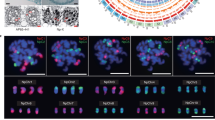Abstract
THE genus Sorghum consists of two groups. Eu-Sorghum includes the tetraploid millet species and an octoploid fodder species1. Para-Sorghum includes only diploid species (n = 5) which are not cultivated. One of these is S. purpureo-sericeum, from the Sudan, in which I have described plants with varying numbers of extra chromosomes. These chromosomes I supposed to be inert2.
This is a preview of subscription content, access via your institution
Access options
Subscribe to this journal
Receive 51 print issues and online access
$199.00 per year
only $3.90 per issue
Buy this article
- Purchase on Springer Link
- Instant access to full article PDF
Prices may be subject to local taxes which are calculated during checkout
Similar content being viewed by others
References
Hunter, A. W. S., Canad. J. Res., 11, 213–241 (1934).
Janaki-Ammal, E. K., Curr. Sci., (1939).
Darlington, C. D., and Upcott, M. B. (1940). J. Genet, (in the Press).
Metz, C. W., Amer. Nat., 72, 485–520 (1938).
Author information
Authors and Affiliations
Rights and permissions
About this article
Cite this article
JANAKI-AMMAL, E. Chromosome Diminution in a Plant. Nature 146, 839–840 (1940). https://doi.org/10.1038/146839a0
Issue Date:
DOI: https://doi.org/10.1038/146839a0
This article is cited by
-
Cytogenetic studies on natural populations of grasshoppers with special reference to B-chromosomes
Chromosoma (1973)
-
B-chromosomes in Iseilema laxum Hack. I. Cytology
Genetica (1972)
-
Chromosomal Elimination induced by 6-Aza-Uracil
Nature (1961)
-
Occurrence of B-chromosomes in diploid Allium stracheyi Baker and their elimination in polyploids
Chromosoma (1961)
-
Konstanz und Variabilit�t der Chromosomenzahl bei einigen Anthurien unter besonderer Ber�cksichtigung der B-Chromosomen
Chromosoma (1956)
Comments
By submitting a comment you agree to abide by our Terms and Community Guidelines. If you find something abusive or that does not comply with our terms or guidelines please flag it as inappropriate.



